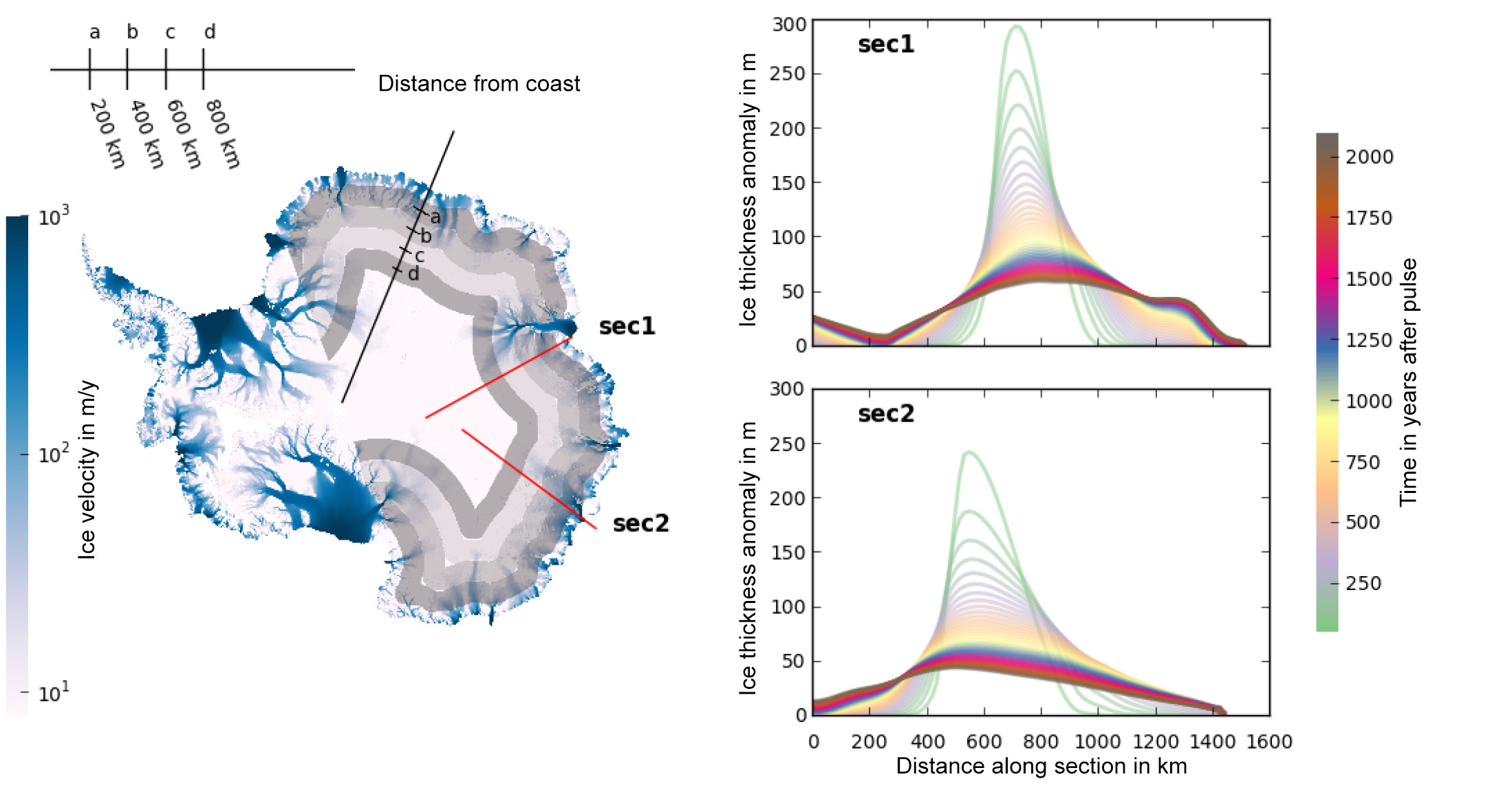|
Discussion on Global Adaptation to Sea-level Rise
Delaying future sea-level rise by storing water on Antarctica |
|
The idea
|
| On this page we collect arguments around the idea of delaying future sea-level rise by pumping ocean water onto Antarctica. It is neither meant to advocate nor dismiss such a project. By contrast, we seek to list the benefits, potential tradeoffs and problems since ultimately the question of whether the magnitude and nature of the sea-level problem necessitates the technical effort and justifies the interference with the Antarctic climate and ecosystem needs to be addressed by the society as a whole. |

|
Figures
left: Strips on Antarctica where the ocean water is pumped in the different computer simulations right: Surface wave that is generated by the additional hill of ice that is created by the addition of the ocean water (along the sections sec 1 and sec 2 shown in the left figure). For a detailed explanation see original publication below. |
|
The basic concept
» Sea-level rise can be delayed by pumping ocean water onto Antarctica » Antarctica's very low temperatures freeze the water into ice. » Sea level declines worldwide. » The ice is slowly returned to the ocean by a surface wave (see figure). » Return time depends on the distance from the coast » Return time is 1000 years for a distance of 800km » Return time does not depend on the amount of ice placed » Very large amounts of energy are required for pumping ocean water onto the ice sheet |
Original publication:
|
K. Frieler, M. Mengel, A. Levermann
| Delaying future sea-level rise by storing water on Antarctica Earth System Dynamics 7 (2016), 203-210, doi:10.5194/esd-7-203-2016. |
| Discussion on the method |
| Pro arguments |
| (P1) Reducing global sea-level rise is a global adaptation measure easing pressure on all coastlines independent of their economic value. |
| (P2) It is ice-dynamically possible to delay sea-level rise by pumping ocean water onto Antarctica |
| (P3) Antarctica's interior has almost no ecosystem that would be perturbed. |
| (P4) The Antarctic ice sheet is one of the slowest dynamical systems in the climate system. |
| (P5) There is a lot of wind energy on and around Antarctica. |
| (P6) Increasing the demand for wind energy might have positive economic effects for the global wind-power industry and the compatibility of renewable energies worldwide. |
| (P7) ... |
| Contra arguments |
| (C1) The currently unperturbed continent Antarctica would carry a sizable industrial compound. |
| (C2) Approximately 10% of the global energy supply is needed to pump 3 mm/year of global sea-level equivalent onto the Antarctic ice sheet, mainly because of its height above sea-level. |
| (C3) The Antarctic ice sheet consists of compressed snow while the added ice would be frozen salt water. The implications for future ice flow are unclear. |
| (C4) Sea-level rise can only be delayed and will be stronger in the future. |
| (C5) Large-scale extraction of water from the Southern Ocean will perturbe the marine ecosystem around Antarctica. |
| (C6) Salty water is extracted from the Southern Ocean with possible implications for the ocean circulation |
| (C7) Latent heat release into Antarctica's atmosphere from the freezing of ocean water |
| (C8) Wind energy extraction from Antarctica's atmosphere |
| (C9) Heat release from the industrial construction that is needed on Antarctica (pipelines, pumps, wind power plants, etc.) |
| (C10) ... |
| Research Questions and Technical Challenges |
| (Q1) Should the water be added in liquid form or as snow? |
| (Q2) Development of pumping technology for the extreme weather of Antarctica (cold, dry, windy). |
| (Q3) Development of wind energy technology of the extreme weather of Antarctica (cold, dry, windy). |
| (Q4) How does the salty ice change the ice dynamics of the Antarctic ice sheet? |
| (Q5) How is the coastal ecosystem of Antarctica perturbed by the large-scale industrial complex installed? |
| (Q6) Is the atmospheric circulation changed by the release of latent heat of the freezing water? |
| (Q7) What is the surface wave dynamics of an ice sheet? |
| (Q8) How is the ice flow changed by the industrial complex that would need to be installed? |
| (Q9) How can the ocean water be kept liquid on its path inland? |
| (Q10) How strong is the change in Earth's shape if Antarctica carries more ice than before? |
| (Q11) Where should the ice be added? |
| (Q12) What is the risk of instabilities induced by the procedure? |
| (Q) ... |
Join the discussion
| Join an unmoderated Twitter discussion @SlrDelay | |
|
|
Join an unmoderated Facebook discussion |
| For truly new arguments or alterations, please mail to sealeveldelay@pik-potsdam.de |
Public Discussion on the Topic
operated by Katja Frieler, Matthias Mengel and Anders Levermann
| Last update: April 2016 | Impressum |




